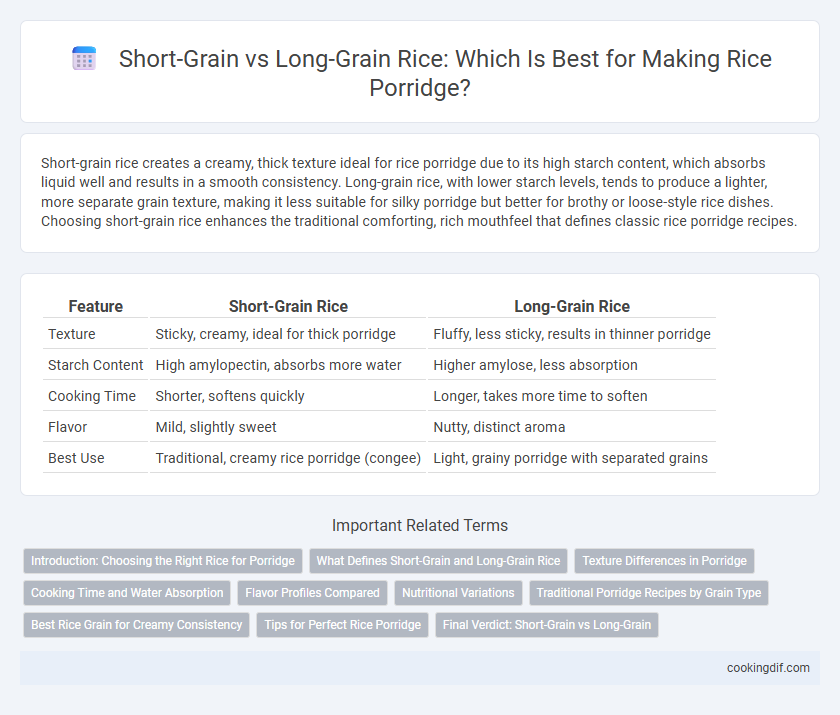Short-grain rice creates a creamy, thick texture ideal for rice porridge due to its high starch content, which absorbs liquid well and results in a smooth consistency. Long-grain rice, with lower starch levels, tends to produce a lighter, more separate grain texture, making it less suitable for silky porridge but better for brothy or loose-style rice dishes. Choosing short-grain rice enhances the traditional comforting, rich mouthfeel that defines classic rice porridge recipes.
Table of Comparison
| Feature | Short-Grain Rice | Long-Grain Rice |
|---|---|---|
| Texture | Sticky, creamy, ideal for thick porridge | Fluffy, less sticky, results in thinner porridge |
| Starch Content | High amylopectin, absorbs more water | Higher amylose, less absorption |
| Cooking Time | Shorter, softens quickly | Longer, takes more time to soften |
| Flavor | Mild, slightly sweet | Nutty, distinct aroma |
| Best Use | Traditional, creamy rice porridge (congee) | Light, grainy porridge with separated grains |
Introduction: Choosing the Right Rice for Porridge
Short-grain rice absorbs more water and releases starch during cooking, creating a creamy, thick texture ideal for traditional rice porridge. Long-grain rice retains a firmer structure with less stickiness, resulting in a lighter, more broth-like consistency preferred in some savory porridge recipes. Selecting the appropriate rice variety depends on desired porridge texture and cultural preference for creaminess or grain separation.
What Defines Short-Grain and Long-Grain Rice
Short-grain rice is characterized by its round, plump kernels that are high in amylopectin, resulting in a sticky, creamy texture ideal for rice porridge. Long-grain rice features slender, elongated kernels with higher amylose content, leading to a fluffy and separate grain consistency that yields a lighter porridge. The starch composition and kernel shape fundamentally differentiate short-grain and long-grain rice, affecting their absorption of water and cooking behavior in porridge recipes.
Texture Differences in Porridge
Short-grain rice creates a creamier and stickier porridge texture due to its higher amylopectin content, making it ideal for smooth, comforting dishes. Long-grain rice results in a lighter, fluffier porridge with distinct, separate grains, perfect for those who prefer a less dense consistency. The choice between short-grain and long-grain rice directly impacts the mouthfeel and viscosity of the final porridge.
Cooking Time and Water Absorption
Short-grain rice absorbs water more efficiently and cooks faster than long-grain rice, making it ideal for creamy, soft porridge textures. Long-grain rice requires a longer cooking time and uses more water to achieve a similar porridge consistency. The sticky nature of short-grain rice enhances porridge creaminess, while long-grain rice results in a thinner, less cohesive dish.
Flavor Profiles Compared
Short-grain rice offers a creamy and slightly sticky texture ideal for porridge, with a naturally sweet and mild flavor that enhances comfort food qualities. Long-grain rice produces a lighter, fluffier porridge with a nutty, slightly floral taste that provides a more distinct and refreshing eating experience. Flavor profiles of short-grain rice porridge suit rich, savory dishes, while long-grain rice complements lighter broths and subtle seasonings.
Nutritional Variations
Short-grain rice contains higher amylopectin, resulting in a creamier texture ideal for porridge, while long-grain rice has more amylose, producing a firmer consistency. Nutritionally, short-grain rice typically offers slightly higher protein and carbohydrate content, whereas long-grain rice provides more fiber and essential minerals like magnesium and phosphorus. These variations influence digestion rates and nutrient absorption, making short-grain rice preferable for smoother porridge with quicker energy release.
Traditional Porridge Recipes by Grain Type
Short-grain rice is ideal for traditional porridge recipes due to its high amylopectin content, which creates a creamy, sticky texture perfect for dishes like congee. Long-grain rice retains its shape better when cooked, resulting in a less viscous, more broth-like porridge favored in some Southeast Asian recipes. Choosing between short-grain and long-grain rice significantly influences the porridge's texture and cultural authenticity, with short-grain offering a thicker consistency and long-grain producing a lighter, more fluid dish.
Best Rice Grain for Creamy Consistency
Short-grain rice is the best choice for creamy rice porridge due to its high starch content, which releases more amylopectin during cooking, creating a naturally thick and smooth texture. Long-grain rice contains less starch and produces a drier, fluffier porridge with less creaminess. For optimal porridge consistency, short-grain rice varieties like Japonica or Arborio provide the ideal balance of stickiness and softness.
Tips for Perfect Rice Porridge
Short-grain rice is ideal for rice porridge due to its higher starch content, which creates a creamy and thick texture essential for a comforting bowl. Long-grain rice tends to be less sticky and can result in a thinner, more watery porridge, so if used, increase the cooking time and water ratio to achieve desired consistency. Rinsing rice before cooking removes excess surface starch, preventing excessive clumping and ensuring a smooth, balanced porridge texture.
Final Verdict: Short-Grain vs Long-Grain
Short-grain rice produces a creamier, stickier porridge ideal for traditional Asian-style congee, while long-grain rice yields a lighter, more separate texture better suited for savory or broth-based porridges. The final verdict depends on the desired porridge consistency and regional preference, with short-grain favored for rich, thick dishes and long-grain chosen for fluffy, less dense results. Texture and cooking time should guide the rice choice to achieve the perfect porridge experience.
Short-grain rice vs Long-grain rice for rice porridge Infographic

 cookingdif.com
cookingdif.com